Artemia worldwide
Artemia is a cosmopolitan , living in pools with an high salt
content or salinity. This small animal thrives in saltlakes in
deserts but also in tropical coastal lagoons.
Artemia and salt
Artemia are worldchampion in osmoregulation: it can remove
salt from its body like no other animal can: And no other
animal can survive in such salty envirronment.
They can also adapt to quick changes in salinity,
caused by rainfall (monsoons).
Those high levels of salt protect them from predators.
The shortage in world supply of Artemia cysts or eggs,
due to the unstable harvest at the Great Salt Lake have
resulted in a very high price for Artemia cysts in 1970.
Since then ,third world lands like India have started
to produce Artemia cysts.
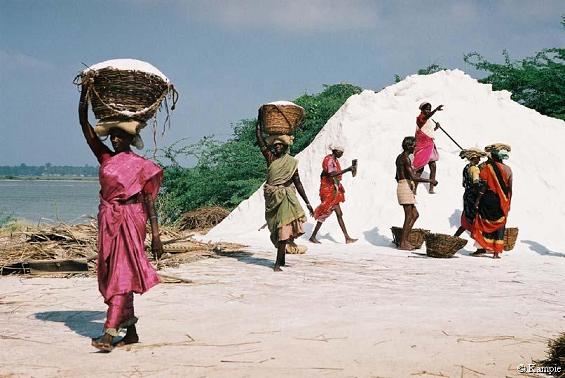
The production of salt in India is mostly done by human labor.
The competition with industrial produced salt makes it hard
to find a living. One third of all saltproduction is done
in those salt works and India is by far the largest producere of seasalt.

Worldsaltproduction
China is the largest player ,surpassing USA. China
and India are the fastest growers.
saltworks: salt and Artemia
There are 2 miljon ha of salt works in India along the
coastline that could be used for the prodction of artemia.
Experimental use of these saltworks resulted in
a production of 4kg of artemia cysts/ha.

Gujarat and Tamil nadu are the largest production area's
in India, although saltworks can be found everywere along
the long coastline of India

The sea saltproduction
in India is for a large amount done by small companies.
Most of the production for the use in India itself
12 kg /each person/year is needed for own salt
consumption. The distribution is mainly done by train.
Artemia in saltworks
The most often used strain of Artemia is the Artemia
franciscana. There are three ways to use artemia and other
organism that flourish in the brine of saltworks:
1 to enhance the salt
production by changing the color of the saltpan:
In this way the evaporation will increase and so the
saltproduction.
2 to produce artemia cyst
3 to produce shrimps that feed on artemia
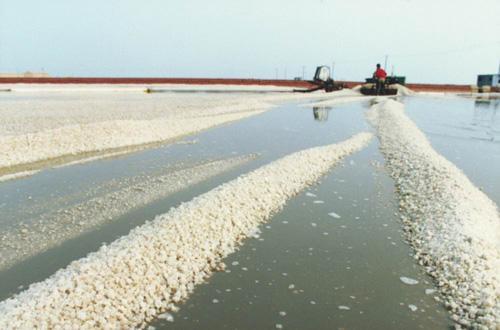
salt in the evaporation saltpan.
Salt production in saltpans.
Lets start with the normal saltproduction in those saltpans:
This is nowadays done in three phases:
First: seawater is pumped in the nurse or evaporation ponds.
Sea water in India is rich in nutrients, evaporation makes the
water more salty until it becomes brine. An algae bloom makes
the salty water a fine place to produce shrimps.
Seconds: As the water gets more salty , only artemia survives
as the most important predator. Gypse salt can also be harvest
here
third: in the last stage halobacteria colors the water red ,
the purple bacteria gives a purple shine, increasing the sunlight
thats absorbed and thus accelerate the evaporation speed.

Artemia production in evaporation or nurse saltpan's
The saltpans that contain brine are an good place for the production
of artemia, the brine gives predators little chance.
The artemia cysts float at the water surface and wash ashore
by wind and waves.The collection of them is done by employ worker
to harvest artemia by a dip net.
For more information, look at Golden Sea Aquaculture Co.,Ltd

Live in a saltpan
Saltpan's can be used for the production of shrimps and fishes.
The saltpans that are low on salinity are very well suited for
that, the shrimps can be feeded with chicken manre and Artemia.

|
Artemia Salina
brine shrimps
Introduction
Brine shrimps (Artemia Salina) are used as a living food
for saltwater fishes. Artemia can be bought in shops
but can be much cheaper produced by yourself.
Artemia is not very suitable as a food source for fresh water
fishes as the brine shrimps die after some minutes in fresh water
Waterfleas are cheaper living food in freshwater.
Artemia are beautiful seen under a miscroscope.
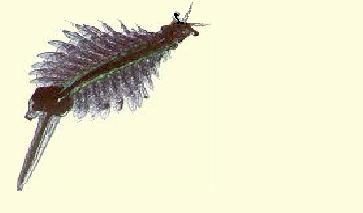
How to make saltwater
Brine shrimps need saltwater, the water need at least to be
as salty as seawater .
This is best done with seasalt used in food or seasalt used to
produce seawater for aquaria.
Dont use tablesalt as this gives a lesser result.
The specific weight needs to be more then 1025 .
Take a look at salinity to
know more about producing seawater.
If the specific weight is much higher then 1025,
the shrimps will grow slower but the population
is more stable(recommended).
Artemia Anatomy
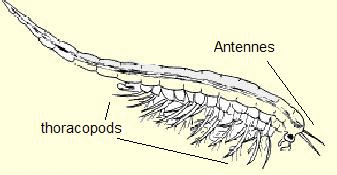
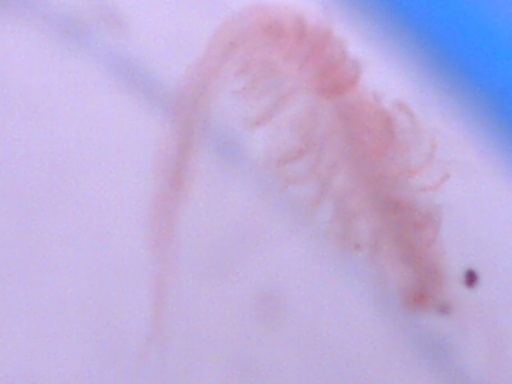
How to feed brine shrimps :
The eggs need to 2 days to transform into nauplii or larvae.
Feeding the nauplii with musselmilk (pulverised mussel)
Musselmilk is made by mixing mussels and cooking it.
is the best and cheapest way to feed nauplii.
Mikrozell is a commercial product that is made for this purpose
but very exspensive.
Feeding the artemia can be done with :
- yeast
- wheat flour
- egg yolk
- soybean powder
- Plancton is the natural food, and is especialy good for the
young brine shrimps or nauplii.
The whole lifespan of Artemia is about one year. the food in
the first eight days is exspensive. For this reason its more
economical to feed with artemia if they are much older.
Temperature
Altough artemia grow faster at temperatures higher then room-
temperature, bacteria do the same.
Brine shrimps larvae or nauplii are very sensible for bacterial growth.
Light
One doesnīt need a special illumination to grow youre artemia.
Bt light can be used to attract the artemia, they are very
fotosensible. illuminate a small part and the artemia gather in
that light spot, and can be harvested.
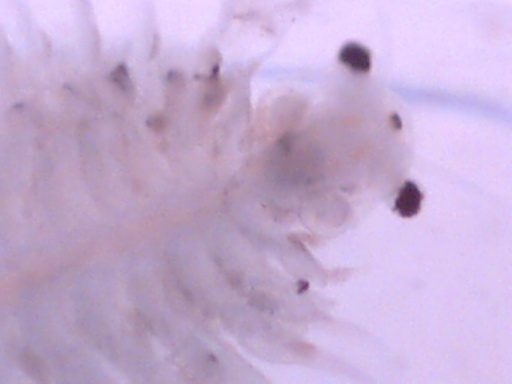
artemia head (200x), with the two 2 eyes and the third eyee.
using aquaria
Aquaria are best suited to produce artemia. In this way algae
will grow more easely, this will improve waterquality and
plancton is a good food source for the nauplii.
Another methode is the use of inverted bottles.
In this methode the salanity of the water is the same as
that of the aquarium, so if you feed youre fishes, the only
thing you have to do is to empty the bottle in the aquarium

Artemia in an inverted bottle
Problems in producing artemia
- Donīt use small airbubbles as they stick to
artemia and pulling the shrimp to the surface.
- Overfeeding is the biggest problem, bacteria will
will reduce youre artemia stock.
- If youre artemia population suddenly dies, a virus is
the cause.
Don't feed the artemia eggs to youre fish
- A good indication for the health of youre brine shrimps
is there reaction to light, the quicker, the more healthier.
If there reaction is slow the most obvious cause is overfeeding.
Artemia has to be pink or yellow, when red theres a lack of oxygen .
How to improve
Keep the water at a PH of 8 or 9 , this is most easely
done by adding some lime stones.
Use the artemia franciscana instead of the artemia from
Salt lake. Artemia franciscana is adapted to lower
temperatures and more stable.
Donīt use much light , as artemia are strongly attracted
to light and waste energy in that way.
the Artemia factory
Artemia can be produced cheapely and most efficient by
using two aquaria: a large one for the production
of plankton and to clean the water, and a small one
for the production of artemia.
The artemiafilter keeps the artemia out of the large
aquarium. The water from the large aquarium is
transported to the smaller by using an airbubble lift.
Producing artemia this way is cheap. Biggest problem is
the filter that need to be cleaned often.

You need a airbubble lift, as an electrical pump wood kill the
algae by its propellor. An airbubble lift is a tube in which air
is pumped at the underside of the tube. The airbubble produces
a flow of water to the upperside of the tube.
The airpump is the
same (membrame)pump as used in aquaria,
artemia and closed systems
These are small aquaria or jars completely sealed
off from the outside world.
Brine shrimps and Halobacteria can stay alive in such
a closed systems for years (sea monkeys ). Such a closed
system can be given as a present to patients in Hospitals or
inmates in a prison.
take a look at closed systems
| |

